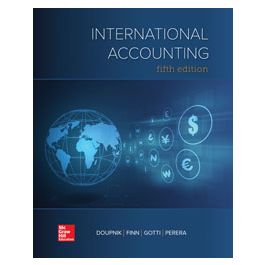Test Bank for International Accounting 5th Edition By Doupnik
$35.00 Original price was: $35.00.$26.50Current price is: $26.50.
Test Bank for International Accounting 5th Edition By Doupnik
This is completed downloadable of Test Bank for International Accounting 5th Edition By Doupnik

Product Details:
Author: Timothy Doupnik; Mark Finn; Giorgio Gotti; Hector Perera
The Fifth Edition of International Accounting provides an overview of the broadly defined area of international accounting, but also focuses on the accounting issues related to international business activities and foreign operations. This edition also includes substantially updated coverage of the International Accounting Standards Board (IASB) and International Financial Reporting Standards (IFRS). The unique benefits of this textbook include its up-to-date coverage of relevant material, extensive numerical examples provided in most chapters, two chapters devoted to the application of International Financial Reporting Standards (IFRS), and coverage of nontraditional but important topics such as strategic accounting issues of multinational companies, international corporate governance, and corporate social responsibility reporting.
Table of Content:
- Chapter 1: Introduction to International Accounting
- Introduction
- Evolution of a Multinational Corporation
- Sales to Customers
- Hedges of Foreign Exchange Risk
- Foreign Direct Investment
- Financial Reporting for Foreign Operations
- International Income Taxation
- International Transfer Pricing
- Performance Evaluation of Foreign Operations
- International Auditing
- Cross-Listing on Foreign Stock Exchanges
- Sustainability Reporting
- Global Accounting Standards
- The Global Economy
- International Trade
- Foreign Direct Investment
- Multinational Corporations
- International Capital Markets
- Outline of the Book
- Summary
- Questions
- Exercises and Problems
- Case 1-1: Besserbrau AG
- Case 1-2: Vanguard International Growth Fund
- Chapter 2: Worldwide Accounting Diversity
- Introduction
- Evidence of Accounting Diversity
- Reasons for Accounting Diversity
- Legal System
- Taxation
- Providers of Financing
- Inflation
- Political and Economic Ties
- National Culture
- Problems Caused by Accounting Diversity
- Preparation of Consolidated Financial Statements
- Access to Foreign Capital Markets
- Comparability of Financial Statements
- Lack of High-Quality Accounting Information
- Classification of Accounting Systems
- A Judgmental Classification of Financial Reporting Systems
- A Simplified Model of the Reasons for International Differences in Financial Reporting
- Examples of Countries with Class A Accounting
- Accounting Change in Europe
- Further Evidence of Accounting Diversity
- Financial Statements
- Format of Financial Statements
- Level of Detail
- Terminology
- Disclosure
- Recognition and Measurement
- Summary
- Appendix to Chapter 2
- The Case of Daimler-Benz
- Questions
- Exercises and Problems
- Case 2-1: The Impact of Culture on Conservatism
- Case 2-2: SKD Limited
- Chapter 3: International Convergence of Financial Reporting
- Introduction
- International Harmonization of Accounting Standards
- Harmonization Efforts through the International Accounting Standards Committee (IASC)
- The “Lowest-Common-Denominator” Approach
- The Comparability Project
- The IOSCO Agreement
- Other Harmonization Efforts
- International Organization of Securities Commissions
- International Federation of Accountants
- European Union
- The International Forum on Accountancy Development (IFAD)
- Challenges to the IASC
- Creation of the IASB
- The Structure of the IASB
- From Harmonization to Convergence of Financial Reporting Standards
- Presentation of Financial Statements (IAS 1/IFRS 1)
- A Principles-Based Approach to International Financial Reporting Standards
- Arguments for and against International Convergence of Financial Reporting Standards
- Arguments for Convergence
- Arguments against Convergence
- The IASB Conceptual Framework
- The Need for a Framework
- Objective of Financial Statements and Underlying Assumptions
- Qualitative Characteristics of Financial Statements
- Elements of Financial Statements: Definition, Recognition, and Measurement
- Concepts of Capital Maintenance
- International Financial Reporting Standards (IFRS)
- Adoption of IFRS
- IAS/IFRS in the European Union
- IAS/IFRS in the United States
- FASB and IASB Joint Conceptual Framework Project
- The Future of IASB/FASB Convergence
- Some Concluding Remarks
- Summary
- Appendix to 3
- What Is This Thing Called “Anglo-Saxon” Accounting?
- Questions
- Exercises and Problems
- Case 3-1: Jardine Matheson Group (Part 1)
- Chapter 4: International Financial Reporting Standards: Part I
- Introduction
- Types of Differences between IFRS and U.S. GAAP
- Inventories
- Lower of Cost or Net Realizable Value
- Property, Plant, and Equipment
- Recognition of Initial and Subsequent Costs
- Measurement Subsequent to Initial Recognition
- Depreciation
- Derecognition
- Investment Property
- Biological Assets
- Fair Value Appraisals and the Relevance-Reliability Trade-Off
- Impairment of Assets
- Definition of Impairment
- Measurement of Impairment Loss
- Reversal of Impairment Losses
- Intangible Assets
- Purchased Intangibles
- Intangibles Acquired in a Business Combination
- Internally Generated Intangibles
- Revaluation Model
- Impairment of Intangible Assets
- Business Combinations and Consolidated Financial Statements
- The Acquisition Method
- Impairment of Goodwill
- The Convergence of Goodwill Impairment Testing Rules
- Borrowing Costs
- Summary
- Questions
- Exercises and Problems
- Case 4-1: Jaguar Land Rover PLC
- Case 4-2: Telco Ltd.
- Chapter 5: International Financial Reporting Standards: Part II
- Introduction
- Current Liabilities
- Provisions, Contingent Liabilities, and Contingent Assets
- Contingent Liabilities and Provisions
- Onerous Contract
- Restructuring
- Contingent Assets
- Additional Guidance
- Employee Benefits
- Short-Term Benefits
- Post-Employment Benefits
- Other Long-Term Employee Benefits
- Share-Based Payment
- Equity-Settled Share-Based Payment Transactions
- Cash-Settled Share-Based Payment Transactions
- Choice-of-Settlement Share-Based Payment Transactions
- Income Taxes
- Tax Laws and Rates
- Recognition of Deferred Tax Asset
- Disclosures
- IFRS versus U.S. GAAP
- Financial Statement Presentation
- Revenue Recognition
- Customer Loyalty Programs
- Financial Instruments
- Definitions
- Liability or Equity
- Compound Financial Instruments
- Classification and Measurement of Financial Assets and Financial Liabilities
- Impairment
- Derivatives
- Sales of Receivables
- Leases
- Disclosure and Presentation Standards
- Statement of Cash Flows
- Events after the Reporting Period
- Accounting Policies, Changes in Accounting Estimates, and Errors
- Related Party Disclosures
- Earnings per Share
- Interim Financial Reporting
- Noncurrent Assets Held for Sale and Discontinued Operations
- Operating Segments
- Summary
- Questions
- Exercises and Problems
- Case 5-1: Accounting for BP PLC’s Deepwater Horizon Oil Spill
- Chapter 6: Foreign Currency Transactions and Hedging Foreign Exchange Risk
- Introduction
- Foreign Exchange Markets
- Exchange Rate Mechanisms
- Foreign Exchange Rates
- Spot and Forward Rates
- Option Contracts
- Foreign Currency Transactions
- Accounting Issue
- Accounting Alternatives
- Balance Sheet Date before Date of Payment
- Hedging Foreign Exchange Risk
- Accounting for Derivatives
- Fundamental Requirement of Derivatives Accounting
- Determining the Fair Value of Derivatives
- Accounting for Changes in the Fair Value of Derivatives
- Hedge Accounting
- Nature of the Hedged Risk
- Hedge Effectiveness
- Hedge Documentation
- Statement of Cash Flows
- Hedging Combinations
- Hedges of Foreign-Currency-Denominated Assets and Liabilities
- Forward Contract Used to Hedge a Recognized Foreign-Currency-Denominated Asset
- Forward Contract Designated as Cash Flow Hedge
- Forward Contract Designated as Fair Value Hedge
- Foreign Currency Option Used to Hedge a Recognized Foreign-Currency-Denominated Asset
- Option Designated as Cash Flow Hedge
- Spot Rate Exceeds Strike Price
- Option Designated as Fair Value Hedge
- Hedges of Unrecognized Foreign Currency Firm Commitments
- Forward Contract Used as Fair Value Hedge of a Firm Commitment
- Option Used as Fair Value Hedge of Firm Commitment
- Hedge of Forecasted Foreign-Currency-Denominated Transaction
- Option Designated as a Cash Flow Hedge of a Forecasted Transaction
- Use of Hedging Instruments
- Summary
- Appendix A to Chapter 6
- Illustration of the Accounting for Foreign Currency Transactions and Hedging Activities by an Importer
- Appendix B to Chapter 6
- Foreign Currency Borrowing
- Questions
- Exercises and Problems
- Case 6-1: Zorba Company
- Case 6-2: Portofino Company
- Case 6-3: Jaguar Land Rover
- Case 6-4: Better Food Corporation
- Chapter 7: Translation of Foreign Currency Financial Statements
- Introduction
- Two Conceptual Issues
- Example
- Balance Sheet Exposure
- Translation Methods
- Temporal Method
- Current Rate Method
- Translation of Retained Earnings
- Complicating Aspects of the Temporal Method
- Disposition of Translation Adjustment
- U.S. GAAP
- FASB ASC 830
- Functional Currency
- Highly Inflationary Economies
- International Financial Reporting Standards
- The Translation Process Illustrated
- Translation of Financial Statements: Current Rate Method
- Translation of the Balance Sheet
- Computation of Translation Adjustment
- Remeasurement of Financial Statements: Temporal Method
- Remeasurement of Income Statement
- Computation of Remeasurement Gain
- Nonlocal Currency Balances
- Comparison of the Results from Applying the Two Different Translation Methods
- Underlying Valuation Method
- Underlying Relationships
- Hedging Balance Sheet Exposure
- Disclosures Related to Translation
- Summary
- Appendix to Chapter 7
- Translation of Foreign Currency Financial Statements in Hyperinflationary Economies
- Questions
- Exercises and Problems
- Case 7-1: Columbia Corporation
- Case 7-2: Palmerstown Company
- Chapter 8: International Taxation
- Introduction
- Investment Location Decision
- Legal Form of Operation
- Method of Financing
- Types of Taxes and Tax Rates
- Income Taxes
- Tax Havens
- Withholding Taxes
- Value-Added Tax
- Tax Jurisdiction
- Worldwide versus Territorial Approach
- Source, Citizenship, and Residence
- Double Taxation
- Tax Treaties
- Model Tax Treaties
- U.S. Tax Treaties
- Treaty Shopping
- OECD Base Erosion and Profit Shifting Action Plan
- Controlled Foreign Corporations
- Subpart F Income
- Determination of the Amount of CFC Income Currently Taxable
- Safe Harbor Rule
- Foreign Tax Credits
- Calculation of Foreign Tax Credit
- Excess Foreign Tax Credits
- FTC Baskets
- U.S. Tax Treatment of Foreign Operation Income
- Example: U.S. Taxation of Foreign Income
- U.S. Tax Reform 2017: Other International Tax Provisions
- Deemed Repatriation of Accumulated Foreign Earnings
- Global Intangible Low-Taxed Income
- Base Erosion Anti-Abuse Tax
- Translation of Foreign Operation Income
- Translation of Foreign Currency Income
- Foreign Currency Transactions
- Summary
- Appendix to Chapter 8
- U.S. Taxation of Expatriates
- Questions
- Exercises and Problems
- Case 8-1: Worldwide United Corporation
- Chapter 9: International Transfer Pricing
- Introduction
- Decentralization and Goal Congruence
- Transfer Pricing Methods
- Objectives of International Transfer Pricing
- Performance Evaluation
- Cost Minimization
- Other Cost-Minimization Objectives
- Interaction of Transfer Pricing Method and Objectives
- Government Reactions
- OECD Guidelines
- U.S. Transfer Pricing Rules
- Sale of Tangible Property
- Licenses of Intangible Property
- Intercompany Loans
- Intercompany Services
- Arm’s-Length Range
- Correlative Relief
- Penalties
- Contemporaneous Documentation
- Reporting Requirements
- Advance Pricing Agreements
- Enforcement of Transfer Pricing Regulations
- Worldwide Enforcement
- Summary
- Questions
- Exercises and Problems
- Case 9-1: Litchfield Corporation
- Case 9-2: International Lamp Company
- Chapter 10: Management Accounting Issues in Multinational Corporations
- Introduction
- Capital Budgeting
- Capital Budgeting Techniques
- Multinational Capital Budgeting
- Illustration: International Wire Company
- Management Control Systems
- Management Control Issues in MNCs
- Performance Evaluation
- Evaluating the Performance of Foreign Operations
- Performance Measures
- Responsibility Centers
- Separating Managerial and Unit Performance
- Choice of Currency in Measuring Profit
- Foreign Currency Translation
- Operational Budgeting
- Choice of Currency in Operational Budgeting
- Incorporating Economic Exposure into the Budget Process
- Culture and Management Control
- Summary
- Questions
- Exercises and Problems
- Case 10-1: Felix Machine Company
- Chapter 11: Auditing and Corporate Governance: An International Perspective
- Introduction
- Corporate Governance Principles
- Auditing and Corporate Governance
- International Dimension
- Professional Accountants’ Role
- International Diversity in External Auditing
- Purpose of Auditing
- Audit Environments
- Regulation of Auditors and Audit Firms
- Audit Reports
- International Standards on Auditing (ISA) and Generally Accepted Auditing Standards (GAAS) in the United States
- Audit Expectation Gap
- International Harmonization of Auditing Standards
- Ethics and International Auditing
- A More Communitarian View of Professional Ethics
- Additional International Auditing Issues
- Auditors’ Liability
- Limiting Auditors’ Liability
- Auditor Independence
- Audit Committees
- Internal Auditing
- The Demand for Internal Auditing in MNCs
- U.S. Legislation against Foreign Corrupt Practices
- Future Directions
- Consumer Demand
- Reporting on the Internet
- Increased Competition in the Audit Market
- Continued High Interest in the Audit Market
- Increased Exposure of the International Auditing Firms
- Tendency toward a Checklist Approach
- Auditing No Longer Only the Domain of the External Auditor
- Different Corporate Governance Models
- Summary
- Questions
- Exercises and Problems
- Case 11-1: Honda Motor Company
- Case 11-2: Daimler AG
- Chapter 12: International Sustainability Reporting
- Introduction
- Theories to Explain the Emergence of Sustainability Reporting
- Investors’ Demand for Sustainability Information
- The Structure of the Sustainability Reporting System
- The Global Reporting Initiative
- Other Sustainability Reporting Frameworks
- Toward Mandatory Sustainability Reporting
- Mandatory Sustainability Reporting in the European Union
- Sustainability Reporting Required by the Hong Kong Stock Exchange
- Mandatory Sustainability Reporting in the United States
- Carbon Emissions Reporting
- Measuring Carbon Emissions
- Sustainability Reporting Practices of MNCs
- Mazda’s 2017 Sustainability Report
- IKEA Group’s 2016 Sustainability Report
- Baxter International’s 2016 Sustainability Report
- Climate Change Disclosures in ExxonMobil’s 2017 Form 10-K
- Summary
- Questions
- Exercises and Problems
- Case 12-1: The Case of Modco Inc.
- Index
People Also Search:
international accounting 5th edition by doupnik
international accounting 5th edition pdf free
international accounting doupnik
international accounting 5th edition ebook











